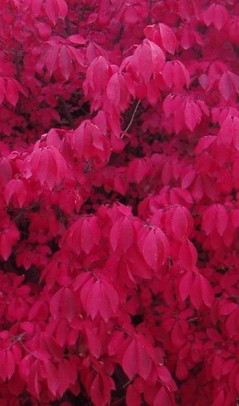 Burning bush, a deciduous shrub native to central and northern east Asia, is grown primarily for its outstanding red fall coloration which gives the plant its common name. The species has corky ridges on the stems and tends to be a large shrub. It produces small insignificant flowers, followed by capsules of orange red seeds. Burning bush grows well in Zones 4 to 8 and is tolerant of a wide range of soils except wet and poorly drained ones. Although it tolerates some shade it produces the best color when grown in full sun. Sometimes fall coloration fails to live up to expectations and this is usually because the plant is gown in shade or the plant was grown from seed. Seed grown plants are variable some having better color than others. One way to avoid disappointment is to grow cultivars known for their exceptional color. Admittedly, burning bush is not a good choice for every garden. In some areas such as New England and the upper Midwest burning bush has become invasive and is crowding out native shrubs. In other places it seems to behave itself. The problem is usually due to heavy self-seeding and efforts are being made to produce cultivars that are sterile.
Burning bush, a deciduous shrub native to central and northern east Asia, is grown primarily for its outstanding red fall coloration which gives the plant its common name. The species has corky ridges on the stems and tends to be a large shrub. It produces small insignificant flowers, followed by capsules of orange red seeds. Burning bush grows well in Zones 4 to 8 and is tolerant of a wide range of soils except wet and poorly drained ones. Although it tolerates some shade it produces the best color when grown in full sun. Sometimes fall coloration fails to live up to expectations and this is usually because the plant is gown in shade or the plant was grown from seed. Seed grown plants are variable some having better color than others. One way to avoid disappointment is to grow cultivars known for their exceptional color. Admittedly, burning bush is not a good choice for every garden. In some areas such as New England and the upper Midwest burning bush has become invasive and is crowding out native shrubs. In other places it seems to behave itself. The problem is usually due to heavy self-seeding and efforts are being made to produce cultivars that are sterile.
There are several cultivars that vary in regard to size, seed production, corkiness, fall color and possibly, hardiness. Here are the most commonly available cultivars.
‘Compacta’
Growing 10’ tall and wider in width, ‘Compacta’ tolerates heavy pruning and can be kept smaller. The corky ridges on the stem are reduced or absent.
‘Chicago Fire’
At 8-10’ ‘Chicago Fire’ has outstanding fall color and is said to be a bit hardier than the species.
‘Fireball’
Known for outstanding fall color, ‘Fireball’ is slightly hardier than the species and grows 5-7’ tall.
‘Rudy Haag’
At 3-5’ tall ‘Rudy Haag’ is the smallest and most compact of the burning bush cultivars. It has outstanding fall color but has inconspicuous fruit.